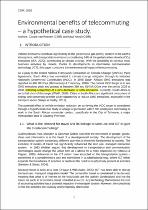JavaScript is disabled for your browser. Some features of this site may not work without it.
- ResearchSpace
- →
- Research Publications/Outputs
- →
- Book Chapters
- →
- View Item
| dc.contributor.author |
Van Reenen, Coralie A

|
|
| dc.contributor.author |
Nkosi, Muzi

|
|
| dc.date.accessioned | 2020-12-05T11:31:41Z | |
| dc.date.available | 2020-12-05T11:31:41Z | |
| dc.date.issued | 2020-10 | |
| dc.identifier.citation | Van Reenen, C. and Nokisi, M. 2020. Environmental benefits of telecommuting - a hypothetical case study. Sustainability Handbook 2020: Volume 1, 97-105 | en_US |
| dc.identifier.isbn | 978-0-620-45240-3 | |
| dc.identifier.uri | https://indd.adobe.com/view/4a3a9e5f-a3cf-4c70-ae51-35dff7911ff7 | |
| dc.identifier.uri | http://hdl.handle.net/10204/11692 | |
| dc.description | Copyright: 2020 alive2green. This is the fulltext version of the work. | en_US |
| dc.description.abstract | Vehicle emissions contribute significantly to the greenhouse gas (GHG) content in the earth’s atmosphere, with transportation emissions constituting 24% of the global carbon dioxide (CO2) emissions (IEA, 2020), contributing to climate change. With the possibility to conduct most business activities by remote, thanks to developments in information communication technology (ICT), this paper considers the environmental impact of telecommuting. As a party to the United Nations Framework Convention on Climate Change (UNFCC) Paris Agreement, South Africa has committed to climate change mitigation through its Intended Nationally Determined Contribution (INDC). In 2015 South Africa’s GHG emissions was reported as 460 Mt CO2e (McSweeney & Timperley, 2018). The current INDC target is to see GHG emissions peak and plateau at between 398 and 614 Mt CO2e over the period 2025 to 2030, following a trajectory of a 42% decrease in GHG emissions. Currently, South Africa is set to fall short of this target (WWF, 2018). Cities in South Africa are significant consumers of energy and conversely provide a key opportunity to reduce GHG emissions, especially in the transport sector (Wolpe & Reddy, 2015). The potential effect of vehicle emission reduction on achieving the INDC target is considered through a hypothetical case study of a large organisation with 2 600 employees commuting to work in the South African commuter context, specifically in the City of Tshwane, a major metropolitan area in Gauteng Province. | en_US |
| dc.language.iso | en | en_US |
| dc.publisher | alive2green | en_US |
| dc.relation.ispartofseries | Worklist;23947 | |
| dc.subject | Climate change | en_US |
| dc.subject | Telecommuting | en_US |
| dc.subject | Greenhouse gas | en_US |
| dc.title | Environmental benefits of telecommuting - a hypothetical case study | en_US |
| dc.type | Book Chapter | en_US |
| dc.identifier.apacitation | Van Reenen, C., & Nkosi, M. (2020). Environmental benefits of telecommuting - a hypothetical case study., <i>Worklist;23947</i> alive2green. http://hdl.handle.net/10204/11692 | en_ZA |
| dc.identifier.chicagocitation | Van Reenen, Coralie, and Muzi Nkosi. "Environmental benefits of telecommuting - a hypothetical case study" In <i>WORKLIST;23947</i>, n.p.: alive2green. 2020. http://hdl.handle.net/10204/11692. | en_ZA |
| dc.identifier.vancouvercitation | Van Reenen C, Nkosi M. Environmental benefits of telecommuting - a hypothetical case study.. Worklist;23947. [place unknown]: alive2green; 2020. [cited yyyy month dd]. http://hdl.handle.net/10204/11692. | en_ZA |
| dc.identifier.ris | TY - Book Chapter AU - Van Reenen, Coralie AU - Nkosi, Muzi AB - Vehicle emissions contribute significantly to the greenhouse gas (GHG) content in the earth’s atmosphere, with transportation emissions constituting 24% of the global carbon dioxide (CO2) emissions (IEA, 2020), contributing to climate change. With the possibility to conduct most business activities by remote, thanks to developments in information communication technology (ICT), this paper considers the environmental impact of telecommuting. As a party to the United Nations Framework Convention on Climate Change (UNFCC) Paris Agreement, South Africa has committed to climate change mitigation through its Intended Nationally Determined Contribution (INDC). In 2015 South Africa’s GHG emissions was reported as 460 Mt CO2e (McSweeney & Timperley, 2018). The current INDC target is to see GHG emissions peak and plateau at between 398 and 614 Mt CO2e over the period 2025 to 2030, following a trajectory of a 42% decrease in GHG emissions. Currently, South Africa is set to fall short of this target (WWF, 2018). Cities in South Africa are significant consumers of energy and conversely provide a key opportunity to reduce GHG emissions, especially in the transport sector (Wolpe & Reddy, 2015). The potential effect of vehicle emission reduction on achieving the INDC target is considered through a hypothetical case study of a large organisation with 2 600 employees commuting to work in the South African commuter context, specifically in the City of Tshwane, a major metropolitan area in Gauteng Province. DA - 2020-10 DB - ResearchSpace DP - CSIR KW - Climate change KW - Telecommuting KW - Greenhouse gas LK - https://researchspace.csir.co.za PY - 2020 SM - 978-0-620-45240-3 T1 - Environmental benefits of telecommuting - a hypothetical case study TI - Environmental benefits of telecommuting - a hypothetical case study UR - http://hdl.handle.net/10204/11692 ER - | en_ZA |






